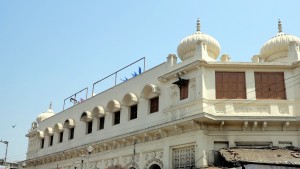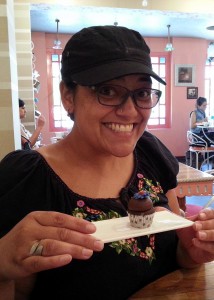I have worked the last two days now at Kalighat, or Nirmal Hriday. This is the first home that Mother Teresa opened in Kolkata. Having volunteered there in 1998 for a couple of months, I was glad when the sister told me to go back there this weekend. I was interested to see if the place would be the same as in my memory. Sure enough, as I approached the door on the first morning, I smelled a familiar smell, the one I have always associated with death. I think, perhaps it is the smell of the disinfectant used at Kalighat – a metallic-y, chemically smell – but I have always linked the two. I steeled myself for the worst, and walked in. Luckily, Friday was the day that the women’s side was being thoroughly cleaned, so the sight that greeted me wasn’t the normal sight of 50+ cots lined up with women in varying states of sickness. Instead, all of the women patients were gathered in chairs in the front area of the women’s wing. The cots and mattresses were all being cleaned and piled up and the floor was being swept and mopped. We volunteers immediately pitched in, some helping with that, while others worked on the breakfast dishes. After all the beds were made and dishes done, we moved on to the laundry. The clothes and bed linens are all washed, wrung, and carried up onto the roof, where they are hung to dry. I enjoy that part – always did.

Some Laundry on roof of Kalighat
From the roof, you can see the streets surrounding Kalighat, as well as the Kali Temple. I remember my father telling me stories about how he could see the priests sacrificing the goats in the mornings in Kali Temple. I’ve certainly never seen that – of course I’ve never been there that early in the morning, but the story is interesting. And since I’d visisted Kali Temple earlier in my trip, I could distinguish the different areas of the temple that I’d seen then. Also, I like the organizing aspect of hanging all the different types of laundry in separate areas of the roof, and this is a time when the volunteers occasionally get to chat a bit. For the most part, the work is to be done without any extra chatter. We are supposed to focus on the service aspect of what we’re doing, rather than on meeting and greeting one another. But it is nice to meet the other people around you. I met a really nice girl from New Zealand who works on a farm, an Indian from Australia, and a guy from the US who coordinates volunteer trips for youths. I enjoyed talking with them, for example, as we gathered in the mornings at the Mother House, on the bus on the way to Kalighat, and again during our chai breaks.
Because of my medical experience, the nurse/sister there allowed me to help with the dressing changes of a couple of the patients. I was given a pair of plastic gloves. Not hospital style, but the kind that you find deli workers wearing – large, clear, disposable, plastic kitchen gloves. I was given one pair, to wear for all of the dressing changes on all of the patients. We either helped them walk or dragged their chairs behind a small wall where the dressing supplies were kept. There was a pitiful collection of two or three different types of ointment, a handful of bandages, and a motley collection of dressings. We pawed through the pile of dressings, looking at each type to see which one would best suit the wound before us. Often, it was a pressure ulcer, sometimes a cut. We’d pick the best option available, and clean the wound with a little saline. Then, we’d apply some ointment (basically Neosporin) and redress the wound. That’s all there was available. It was so inadequate and depressing, I don’t even have the words to describe it.
Later, we fed all of the women their lunch, some by hand, some just distributing the plates and waters, then we did the dishes. We spent a little time with the women, and helped them back to their beds before leaving for the afternoon. Very busy, full mornings, both. They were difficult, too. The women reach out to you as you walk by, asking for things in a language I don’t understand. I don’t have anything to give them, it seems. Even getting water for them is sometimes difficult, as I had to track down a sister or ayah (caregiver girl) and either find out where the cups were or where to get water to refill the pitchers or where to clean the cups etc.
Towards the end of the first day, one lady pulled me down to sit by her on her cot and began speaking to me. She held my hand as she talked, telling me many things. Her eyes filled with tears as she spoke, telling me (I think) how she came to be here, how her life was difficult, but all in Bangla. I think she talked about her health, wanting to get better and go, but to where? She showed me scars from where she’d had surgery, telling how she was still having issues. I could do nothing but empathize with my eyes, and with the wordless vocalizations Indians usually use, the “ah”s and “mmm”s that seem to be all that is required to hold up one end of a conversation. She was happy with that, as she was getting her story off of her chest. I didn’t even realize it was time for the volunteers to leave, that first day, I was so absorbed in her story, in her eyes. When one of the volunteers came to get me, saying it was time to go, I said goodbye, promising to return, and I hurriedly got my belongings and rushed to go. As I did, one of the sisters told me it had been good that I spent time with that patient, however, because apparently she rarely opens up or talks to anyone. I was glad I could at least be there for her. I was sorry that’s all I could do, though. It seems like a pitifully small thing to do for someone – just lend them an ear and give them a smile, but that’s all I had to offer.
It seems, in India, like it’s difficult to know how to help. The beggars have unions and are apparantly a giant scam to get money, so it’s rare that you want to give money to even the most pitiful on the streets. There isn’t much you feel you are actively doing to help if you donate to charities, but when I come to help out at a place like this, I’m overwhelmed by the magnitude of the problem. How many people there are out there, and how little there is that we can do! Simultaneously, I am aware that I’ve become a bit jaded as a healthcare worker. I see other volunteers rushing to help with things that I (and the ayahs and sisters who work there) don’t, saying the patient is fine and can do on her own. I know I’ve been manipulated in the past by many patients who “play up their illnesses” when they are capable of doing more, and in fact do themselves a disservice by not being more independent. But it is easy to become callous over time, rather than simply being tough occasionally in order to encourage independence. Walking that fine line is a challenge. I could see the disillusion and tiredness in several of the Sisters’ eyes. They have the added difficulty of constantly training and retraining new volunteers, as well. They have a tough job.

At lunch with my sister
I was lucky that I was able to leave each afternoon and have time away. One day, my sister and I met for lunch at a lovely tea shop. The other day, the two French women who were couchsurfin for a couple of days with Andrew and Mike at the place I’m staying at cooked us all a delicious dinner – with crepes! It was a nice way to break things up.



